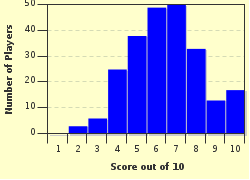Quiz Answer Key and Fun Facts
1. During the Victorian era the Poor Law Commission found that the standard of working class family fare mainly consisted of bread, potatoes, butter,tea and what other ingredient?
2. If poor rural Victorians ate birds then what did poor urban Victorians eat?
3. As a first course appetizer on a rich Victorian household's menu what dish could they have eaten either raw or baked?
4. During the second course what could the Victorians have chosen that was either baked or broiled?
5. Food in the workhouse was purposely prepared as bland as possible. The workhouse diet consisted mainly of bread, cheese and what other ingredient?
6. During the 19th century Victorian food was found to contain poisonous chemicals.
7. In 1877 the Local Government Board found a quarter of the milk that was examined contained excessive water or chalk. What was found to be in 10% 0f bread, 8% of butter and 50% of gin?
8. Even the rich were not safe from contamination of food. The London County Medical Officer found cotton fibres, bed bugs, fleas, human hair, cat and dog hair and lice in ice cream. What diseases did this contamination cause?
9. Exotic foods and spices from the British colonies started to find their way to London. Which dish did Queen Victoria order her kitchen to always have prepared?
10. Famous Victorian cookery writer Mrs Beeton had her "Book of Household Management" published in 1861. What was her first name?
Source: Author
lorstrivia
This quiz was reviewed by FunTrivia editor
Bruyere before going online.
Any errors found in FunTrivia content are routinely corrected through our feedback system.

